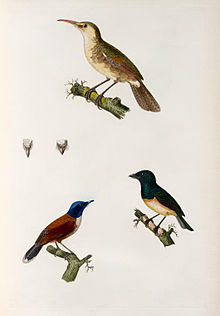Nightingale reed warbler
| Nightingale reed warbler | |
|---|---|

| |
| Nightingale reed-warbler (top) | |
| Scientific classification | |
| Domain: | Eukaryota |
| Kingdom: | Animalia |
| Phylum: | Chordata |
| Class: | Aves |
| Order: | Passeriformes |
| Family: | Acrocephalidae |
| Genus: | Acrocephalus |
| Species: | †A. luscinius
|
| Binomial name | |
| †Acrocephalus luscinius | |
| Synonyms | |
| |
The nightingale reed warbler (Acrocephalus luscinius), or Guam reed-warbler, is an extinct songbird that was endemic to Guam.
Taxonomy and systematics
The nightingale reed warbler was described by the French zoologists
binomial name, Thryothorus luscinius.[2][a] Until 2011, the Pagan reed warbler, Aguiguan reed warbler, and Saipan reed warbler were considered as subspecies of the nightingale reed warbler until split by the IOC.[4]
Extinction
The nightingale reed warbler was driven to extinction by several
ungulates such as goats (Capra hircus) or sheep (Ovis aries).[5] An introduced plant, ivy gourd (Coccinia grandis), destroyed the canopy of the trees that nightingale reed warblers built their nests in. Wetland destruction, fires and pesticides, as well as intensive land use for agriculture or building further reduced the available habitat.[6]
It has not been seen since 1969.
Nesting
The nightingale reed warbler is nonmigratory and nests year round. The typical clutch has two
eggs that are white with a green tint and are covered in lavender, chestnut, and black spots. [7]
Notes
References
- . Retrieved 13 November 2021.
- ^ Quoy, Jean; Gaimard, Joseph Paul (1830). Dumont d'Urville, Jules (ed.). Voyage de la corvette l'Astrolabe : exécuté par ordre du roi, pendant les années 1826-1827-1828-1829: Zoologie (in French). Vol. 1. Paris: J. Tastu. pp. 202–203.
- ^ Mlíkovský, Jiří (2012). "The dating of the ornithological part of Quoy and Gaimard's "Voyage de l'Astrolabe"". Zoological Bibliography. 2 (2&3): 59–69.
- ^ "Species Version 2 « IOC World Bird List". www.worldbirdnames.org. Retrieved 2018-06-13.
- ^ Rounds, Rachel; Radley, Paul. "Nightingale Reed-Warbler (Acrocephalus luscinia)". Web Page of Pacific Bird Conservation, Hawaii. Archived from the original on 21 September 2015. Retrieved 21 September 2015.
- .
- ^ Beacham, Walton; Castronova, Frank; Sessine, Suzanne (2000). Beacham's Guide to the Endangered Species of North America. Vol. 1. Gale. pp. 435–437.

